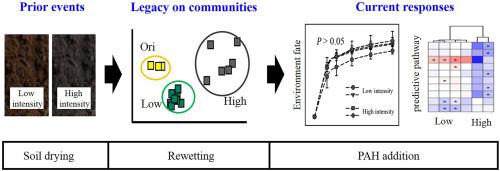Environmental Pollution ( IF 7.6 ) Pub Date : 2023-05-26 , DOI: 10.1016/j.envpol.2023.121909 Jun Zeng 1 , Yanjie Li 1 , Yeliang Dai 1 , Qinghe Zhu 2 , Yucheng Wu 1 , Xiangui Lin 1

|
Alteration of the structure of soil microbial communities following the elimination of hydrophobic organic pollutants (e.g., polycyclic aromatic hydrocarbons, PAHs) is generally assessed using DNA-based techniques, and soil is often required to dry prior to pollutant addition, to facilitate a better mix when establishing microcosms. However, the drying practice may have a legacy effect on soil microbial community structure, which would in turn influence the biodegradation process. Here, we used 14C-labeled phenanthrene to examine the potential side effects of precedent short-term drought events. The results indicate that the drying practice had legacy effects on soil microbial community structure, illustrated by irreversible shifts in the communities. The legacy effects had no significant impact on phenanthrene mineralization and non-extractable residue formation. However, they altered the response of bacterial communities to PAH degradation, leading to a decrease in the abundance of potential PAH degradation genes plausibly attributed to moderately abundant taxa. Based on a comparison of the varied effects of different drying intensity levels, an accurate description of microbial responses to phenanthrene degradation strongly relies on the establishment of stable microbial communities before PAH amendment. Concurrent alterations in the communities resulting from environmental perturbation could greatly mask minor alterations from the degradation of recalcitrant hydrophobic PAH. In practice, to minimize the legacy effects, a soil equilibration step with a reduced drying intensity is indispensable.
中文翻译:

土壤干燥遗留物不会影响土壤中菲的命运,但会改变细菌群落的反应
消除疏水性有机污染物(例如,多环芳烃,PAH)后土壤微生物群落结构的改变通常使用基于 DNA 的技术进行评估,并且通常需要在添加污染物之前干燥土壤,以促进更好的混合在建立微观世界时。然而,干燥做法可能对土壤微生物群落结构产生遗留影响,进而影响生物降解过程。在这里,我们使用了14C-标记的菲检查先例短期干旱事件的潜在副作用。结果表明,干燥做法对土壤微生物群落结构有遗留影响,表现为群落的不可逆转变化。遗留效应对菲矿化和不可萃取残留物的形成没有显着影响。然而,它们改变了细菌群落对 PAH 降解的反应,导致潜在 PAH 降解基因的丰度减少,这可能归因于适度丰富的类群。基于对不同干燥强度水平的不同影响的比较,对微生物对菲降解反应的准确描述强烈依赖于在 PAH 修正之前建立稳定的微生物群落。环境扰动导致的群落并发变化可能会极大地掩盖顽固疏水性 PAH 降解引起的微小变化。在实践中,为了尽量减少遗留影响,降低干燥强度的土壤平衡步骤是必不可少的。











































 京公网安备 11010802027423号
京公网安备 11010802027423号